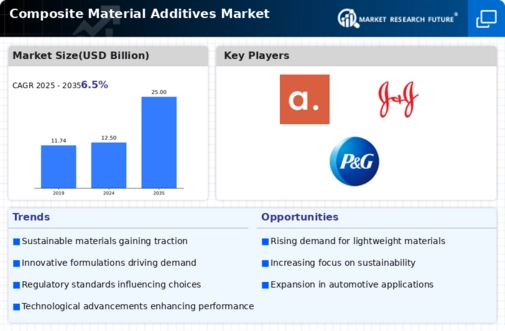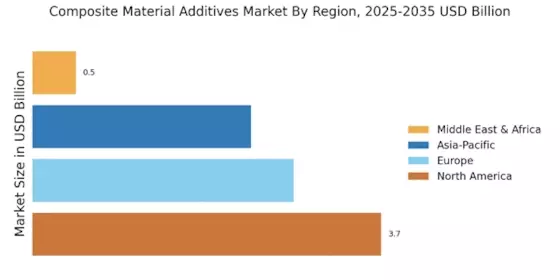Regulatory Compliance
Regulatory compliance is becoming increasingly critical within the Composite Material Additives Market. Governments and regulatory bodies are implementing stringent guidelines regarding the use of additives, particularly concerning health and environmental impacts. Companies are compelled to adapt their formulations to comply with these regulations, which can drive innovation and lead to the development of safer, more sustainable products. The market is witnessing a shift towards additives that not only meet regulatory standards but also enhance product performance. This compliance-driven approach is likely to influence market dynamics, as companies that proactively address regulatory challenges may gain a competitive advantage. The emphasis on compliance is expected to shape the future landscape of the Composite Material Additives Market.
Technological Innovations
Technological advancements are playing a pivotal role in the evolution of the Composite Material Additives Market. Innovations in additive manufacturing, nanotechnology, and smart materials are enhancing the performance and functionality of composite materials. For instance, the integration of nanofillers can significantly improve mechanical properties, thermal stability, and resistance to environmental factors. The market is witnessing a surge in research and development activities aimed at creating high-performance additives that cater to specific industry needs. As a result, the demand for advanced composite materials is expected to rise, with projections indicating a market growth rate of approximately 8% annually. This technological evolution is not only expanding the application scope of composite materials but also driving the overall growth of the Composite Material Additives Market.
Sustainability Initiatives
The increasing emphasis on sustainability within the Composite Material Additives Market is driving demand for eco-friendly additives. Manufacturers are increasingly adopting bio-based and recyclable materials to meet regulatory standards and consumer preferences. This shift is not merely a trend but a necessity, as industries face pressure to reduce their carbon footprints. The market for sustainable composite materials is projected to grow significantly, with estimates suggesting a compound annual growth rate of over 10% in the coming years. Companies that prioritize sustainability in their product offerings are likely to gain a competitive edge, as consumers become more environmentally conscious. This focus on sustainability is reshaping the landscape of the Composite Material Additives Market, encouraging innovation and the development of new, greener products.
Customization and Specialization
The trend towards customization and specialization is increasingly influencing the Composite Material Additives Market. As industries such as automotive, aerospace, and construction seek tailored solutions to meet specific performance criteria, the demand for specialized additives is on the rise. Manufacturers are responding by developing bespoke formulations that enhance properties such as strength, durability, and resistance to chemicals. This shift towards customization is expected to propel market growth, with estimates suggesting that specialized additives could account for a significant portion of the market share in the near future. The ability to offer customized solutions not only meets client demands but also fosters innovation within the Composite Material Additives Market, encouraging companies to invest in research and development.
Growing Demand in Emerging Markets
Emerging markets are presenting new opportunities for growth within the Composite Material Additives Market. As industrialization accelerates in regions such as Asia-Pacific and Latin America, the demand for composite materials is rising. This growth is driven by sectors such as construction, automotive, and consumer goods, which are increasingly adopting composite materials for their lightweight and durable properties. Market analysts project that the demand for composite additives in these regions could increase by over 15% in the next few years. Companies that strategically position themselves to tap into these emerging markets may benefit from substantial growth opportunities. The expanding middle class and increasing infrastructure investments in these regions are likely to further bolster the Composite Material Additives Market.


















Leave a Comment